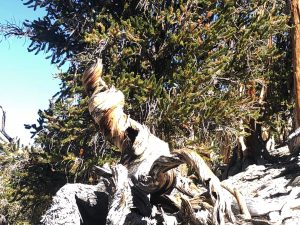I spent mid-August to mid-September at a writer’s residency offered by the good sisters at the Monastery of St. Gertrude in Cottonwood, Idaho, population 923.
It was good to get away. But it also felt really, really good to be heading back to Southern California in my trusty Fiat 500.
En route, down through Boise, then 250 miles of breathtaking desert vistas to Winnemucca, Nevada, then hundreds of more miles the next morning, I made my way to a place I’ve wanted to visit for many years: the Ancient Bristlecone Forest in the Eastern Sierras.
Navigating there required several deserted back roads, the loss of all cell reception, and a 23-mile drive through the eastern portion of CA-168 W to White Mountain Road in what is technically Bishop, at which point there’s still 10-miles more of Inyo National Forest road to go, up, up, and up some more.
I’d already driven close to six hours that day, so I was especially grateful to wheel into the parking lot of the Schulman Grove Visitor’s Center. (Edmund Schulman, Ph.D., 1908-1958, was a University of Arizona dendrochronologist with a background in astronomy who, entirely sensibly to my mind, related cosmic events to the science of tree-ring dating).
At 10,000 feet the warmth of the sun was overlain with the faint chill of early fall and the fresh, dreamy scent of pine.
Past the Visitor’s Center, White Mountain Road becomes graded dirt. Hardy types can drive on 12 more miles to Patriarch Grove, home of the world’s largest bristlecone pine.
Those with high-clearance vehicles can drive four miles beyond that, then embark upon a 14-mile round-trip hike to the 14,246-foot peak. Neighboring canyons provide camping, hiking, and bighorn sheep-sighting opportunities galore.
But the bristlecones are among the oldest living trees on earth, and to witness them at close range, I was fine where I stood. The grounds were ringed with them, and they grew all up the facing slope: wise old crones and ancient priests, I imagined, who kept their own counsel.
The outdoor plaques and indoor exhibits provided ample context. Six hundred fifty million years ago the site was a sea bed. Most plants can’t tolerate the resulting rocky dolomitic soil, which means the bristlecones grow here mostly unchallenged.
In fact, the trees thrive on adversity, with the high altitude, dry summers, and severe winters paradoxically promoting longer life. The short growing season produces extremely dense and resinous wood, which repels all manner of insect, heart rot, and fire.
Almost alone in the tree world, the bristlecone can lose up to 90% of its bark and still survive, “with just a narrow bark strip connecting the live limbs and roots.” Just like us resilient humans, I thought, massaging my back, and already reflecting upon the piece I planned to write.
Plus, bristlecones grow both male and female cones on the same tree. In mid-summer of the first year, the rust-colored male cones release clouds of fine yellow pollen that fertilize the female cones. How romantic is that?
To commune with the trees, the visitor has the choice of three trails: the Discovery Trail, a short loop hike where Schulman discovered the world’s first-known 4,000-year-old tree; the Bristlecone Cabin Trail, also short, where you can learn about “an early mining effort” in the White Mountains; and the Methuselah Walk Trail, a 4.5-mile “longer, more intimate hike” offering a view onto northern Death Valley and featuring a 900-foot gain in elevation.
Shaky from my long drive, both anxious and excited about returning to LA after an almost six-week absence, and not entirely sure I could complete 4 1/2 miles of hills at 10,000 feet, I of course chose the Methuselah Trail. “Do it for the archdiocese,” I told myself bravely.
So off I set, starting at 1:30 p.m., and had one of the most beautiful hikes in recent memory. I walked, I prayed the Luminous Mysteries, I marveled at the gnarled trees — some more than 4,700 years old — with their groping branches and silvered trunks, each as distinct as a seashell or a snowflake.

Around the halfway mark, I came upon a trio of fellow hikers. “This is it,” one guy said. “They won’t tell us the exact tree, because people would wreck it, but somewhere around here is Methuselah — the oldest bristlecone in the forest.”
I gazed up at the towering treetops, the rocky slopes, the chalky, blue mountain peaks in the distance. I thought of my time away: the silence, the solitude, the perfectly flat prairie that — call me shallow — at the end had started ever so slightly to pall.
Tomorrow at this time I’d be home: the noise, the smog, the energy; the aching Southern California light, the ripening persimmons, the difficult neighbors, the dashing-around-town excursions for my column. Home to the city I loved, that had given me the Church and my vocation, that for 30 years and counting had pruned me with her adversities and her beauty.
“Better soil conditions and water availability may produce taller and larger trees,” my brochure pointed out, “but they will not live long enough to become one of the ancients.”

